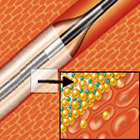|
IN.PACT SFA II is a prospective, multicenter, randomized controlled trial that enrolled 181 patients at more than 40 U.S. sites and randomized them 2:1 to treatment with either the IN.PACT Admiral drug-eluting balloon (study arm) or a traditional, non-coated angioplasty balloon (control arm). Its primary efficacy endpoint is primary patency, a measure of blood flow through the treated arterial segment, at 12 months. The principal investigators of IN.PACT SFA II are interventional cardiologist Dr. John Laird, professor of medicine at the University of California Davis and medical director of the UC Davis Vascular Center, and vascular surgeon Dr. Peter Schneider, chief of the vascular therapy division at Kaiser Foundation Hospital and Hawaii Permanente Medical Group in Honolulu. Results of IN.PACT SFA II will be combined with those from IN.PACT SFA I, which previously completed enrollment of 150 patients in Europe, to support a premarket approval (PMA) application to the U.S. Food and Drug Administration (FDA). "The European experience with IN.PACT drug-eluting balloons shows a promising interventional treatment for peripheral artery disease in the lower extremities," said Dr. Prakash Krishnan, assistant professor of medicine and director of endovascular intervention at Mount Sinai Heart in New York, and the highest enroller of patients in IN.PACT SFA II. "We look forward to sharing the U.S. experience of this innovative medical technology as the results of IN.PACT SFA II become available." PACIFIER Trial Results The prospective, multicenter, corelab-adjudicated, randomized controlled PACIFIER trial enrolled 85 patients with femoropopliteal lesions. Conducted in three German institutions, it included 91 randomized cases –– 44 treated with a drug-eluting balloon (study arm); 47 treated with a non-coated balloon (control arm). The study met its primary endpoint by showing a statistically significant difference in reduction of late lumen loss at six months for the cases that used a drug-eluting balloon as compared to those that used a non-coated balloon (-0.01mm vs. 0.65mm, p=0.001). The PACIFIER trial defined major adverse events as death, amputation or target lesion revascularization. At 12 months, there were significantly fewer major adverse events in the study arm as compared to the control arm (7.1 percent vs. 34.9 percent, p=0.003). All three of the major adverse events in the study arm were target lesion revascularizations; the control arm included 15 target lesion revascularizations and three deaths. None of the patients in the study had an amputation. IN.PACT Clinical Program The ongoing global IN.PACT clinical program includes 29 studies involving more than 4,600 patients at approximately 230 sites worldwide. Through these company-sponsored and physician-initiated studies, Medtronic's portfolio of IN.PACT drug-eluting balloons will be investigated thoroughly for the treatment of arterial disease in a variety of vessel beds. As part of this program, Medtronic is currently enrolling the IN.PACT Global study, a first-of-its kind "real-world" evaluation of the company's IN.PACT drug-eluting balloons involving 1,500 patients with femoropopliteal lesions of any length at up to 80 sites worldwide. IN.PACT drug-eluting balloons feature a proprietary coating called FreePac that is a formulation of paclitaxel and urea, an excipient that facilitates absorption of the drug into the vessel wall. They received the CE (Conformité Européenne) mark in 2008 and 2009 and are available in many countries around the world. In the United States, the IN.PACT Admiral drug-eluting balloon is limited to investigational use under an investigational device exemption (IDE) granted by the FDA and, like every drug-eluting balloon, is not yet commercially available. In collaboration with leading clinicians, researchers and scientists worldwide, Medtronic offers the broadest range of innovative medical technology for the interventional and surgical treatment of cardiovascular disease and cardiac arrhythmias. The company strives to offer products and services that deliver clinical and economic value to healthcare consumers and providers around the world. About Medtronic Any forward-looking statements are subject to risks and uncertainties such as those described in Medtronic's periodic reports on file with the Securities and Exchange Commission. Actual results may differ materially from anticipated results. Source: Medtronic, Inc. |

